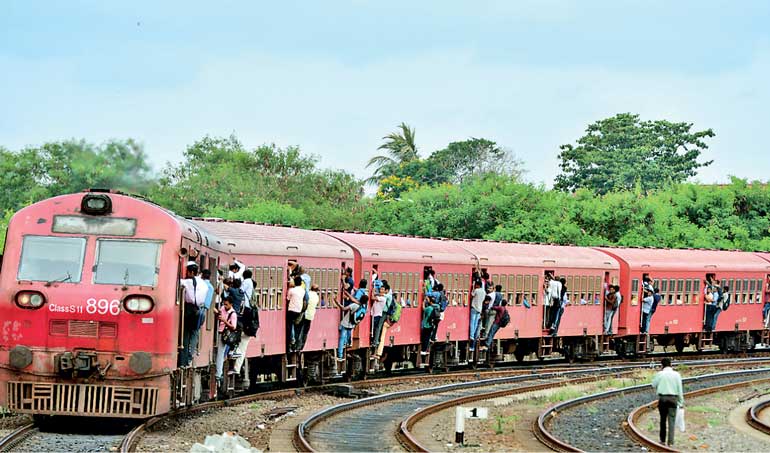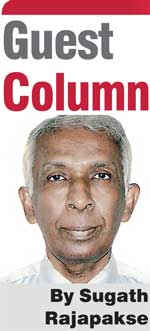Wednesday Mar 12, 2025
Wednesday Mar 12, 2025
Friday, 30 March 2018 00:00 - - {{hitsCtrl.values.hits}}

 Situation analysis
Situation analysis
Sri Lanka Railway has been running at a loss all the time. As per data available, even in 2015 the Railway made an operational loss of nearly Rs. 7,000 million. Railway is a transport system that is far greener than the road transport, able to carry more passengers and cargo at a far lesser cost. Thus the important thing is to find that mechanism which will enable the Railway to at least make an operating profit.
Passenger rail transport has burdened the Government with high losses year after year with no end to it in sight. There are various news items where it is stated that Railway is thinking of increasing the fares by 15%, while elsewhere the GM Railway has stated that there is no such plan to increase fares. Still if a solution can be found to cover the direct operating costs and also contribute to the overheads and other fixed costs including the relaying of lines for increasing efficiency and to provide a much more comfortable transport experience, then it is worthwhile looking into same. Of course I do not for once say that this is the best or the only alternative, but yet is based on successful operation of rail transport in other countries, using online booking system and revenue management.
Passenger rail
The key components of passenger rail as I see are:
Though these are the key aspects, with our railway there is no Internet Booking Engine (IBE) or payment gateway facilities. Bookings can only be made 30 days prior to departure date and no online facilities other than with mobile network support of Mobitel, Etisalat and landlines with SLT. The present 30 days’ prior restriction does not help railway to improve its cash flow. On the other hand, even though there are links to SriLankan Airlines and Tourist Board sites, yet there is no lateral integration with hotels or any Homestay products, which can enable railway to capture more of the tourist traffic.
Currently I note that there are more than 16 intercity trains operating to many destinations from Colombo, Jaffna, Kandy, Anuradhapura, etc. with First and Second Class compartments.
Passenger mix
With growth in tourism and post 2009 where many tourists have opted for public transport, you will find often the First Class to places like Jaffna, Anuradhapura, Kandy, Nanu Oya, etc. often filled with foreign tourists.
As an example if one takes the first class rail fare on return basis to Jaffna, it is Rs. 3,000 for all, be they foreign tourists or Sri Lankans. The distance by train from Colombo to Jaffna is about 397km. However, in Britain from London to Manchester by Virgin Rail, a distance of 308km, the web only rate for a return first class ticket is GBP 149 off peak while anytime fare is GBP 242 in first class. The lower fare at current exchange rate is Rs. 33,078 and anytime fare would be Rs. 53,724.A journey by train from Frankfurt to Munich in Germany also has various ticket prices. On midweek days, it can cost Euro 128.80 or Rs. 24,987 for a return ticket and there are different booking patterns.
Also it has to be noted by Railway authorities that tourists make travel plans to Sri Lanka from UK and Europe three to six months or even earlier. Of course given the digital booking operations of OTA some tourists may book even closer to the actual travel date from the host country to Sri Lanka.
Rail passenger psychographics
Britain for example has a GDP per capita income of $ 43,620 while that of Sri Lanka the per capita GDP is $ 3,905. Despite this very high income, for a first class return ticket from Colombo to Jaffna they need to pay only $ 19.23. I am not saying even for one moment to have a discriminatory pricing structure for foreigners, but to have the mechanism in place to not only maximise revenue but to improve the cash flow to the Railway coffers. This will enable not only foreigners but even locals to buy online and not keep running to railway stations.
The present booking system either at station or by phone is open for abuse. I have noted this myself when travelling to Nanu Oya in February 2016.
Way forward for
railway passenger
revenue optimisation
The solution is right there and that is the use of an Internet Booking Engine (IBE) with a payment gateway. All the first class and second class seat inventory can be put in separate buckets with different seat pricing and availability well in advance.
For example, if there are two First Class coaches to Jaffna then there are 88 seats. These can be apportioned to separate inventory buckets with different price structures to be booked and paid online. The higher fare for booking at any timecould be say for example$ 100. There can be other prices such as $ 80, 60, 40, etc.
For example, under the present pricing structure, if all the 88 seats are sold, then the total income is Rs. 264,000 for return journey. With differential pricing in a nested structure, it can bring Rs. 960,960 income to Railway, a 264% increase over the present pricing strategy. Also prices can be adjusted depending on the seasonality of tourism and inventory in seat buckets adjusted based on how advance sales are taking place. In addition to huge increase in revenue, Railway will also make sales well in advance of the travel date, thereby improving the cash flow.
The same pricing and inventory strategy can be adopted even for economy class travel in intercity trains with a certain mass of seats being made available to local people.
Conclusion
The solution to the loss-making railway is not through across the board fare increase where the citizens of our country will be put under the pressure of increased costs, but adoption of an online booking system where buyers can buy online and make payments well in advance so that Railway can optimise the revenue.
Such a pragmatic approach can easily reduce the losses and even make profits so that the Government need not keep funding the lossmaking venture just as with our national airline with taxpayers’ money.
(The writer can be reached via
[email protected].)
Discover Kapruka, the leading online shopping platform in Sri Lanka, where you can conveniently send Gifts and Flowers to your loved ones for any event including Valentine ’s Day. Explore a wide range of popular Shopping Categories on Kapruka, including Toys, Groceries, Electronics, Birthday Cakes, Fruits, Chocolates, Flower Bouquets, Clothing, Watches, Lingerie, Gift Sets and Jewellery. Also if you’re interested in selling with Kapruka, Partner Central by Kapruka is the best solution to start with. Moreover, through Kapruka Global Shop, you can also enjoy the convenience of purchasing products from renowned platforms like Amazon and eBay and have them delivered to Sri Lanka.
Discover Kapruka, the leading online shopping platform in Sri Lanka, where you can conveniently send Gifts and Flowers to your loved ones for any event including Valentine ’s Day. Explore a wide range of popular Shopping Categories on Kapruka, including Toys, Groceries, Electronics, Birthday Cakes, Fruits, Chocolates, Flower Bouquets, Clothing, Watches, Lingerie, Gift Sets and Jewellery. Also if you’re interested in selling with Kapruka, Partner Central by Kapruka is the best solution to start with. Moreover, through Kapruka Global Shop, you can also enjoy the convenience of purchasing products from renowned platforms like Amazon and eBay and have them delivered to Sri Lanka.